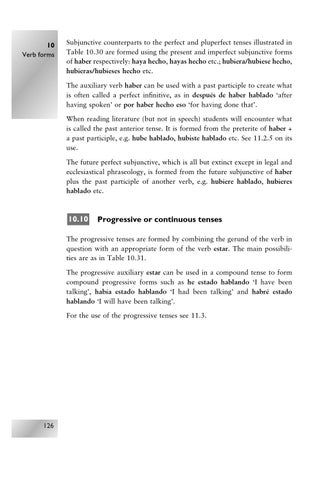10 Verb forms
Subjunctive counterparts to the perfect and pluperfect tenses illustrated in Table 10.30 are formed using the present and imperfect subjunctive forms of haber respectively: haya hecho, hayas hecho etc.; hubiera/hubiese hecho, hubieras/hubieses hecho etc. The auxiliary verb haber can be used with a past participle to create what is often called a perfect infinitive, as in después de haber hablado ‘after having spoken’ or por haber hecho eso ‘for having done that’. When reading literature (but not in speech) students will encounter what is called the past anterior tense. It is formed from the preterite of haber + a past participle, e.g. hube hablado, hubiste hablado etc. See 11.2.5 on its use. The future perfect subjunctive, which is all but extinct except in legal and ecclesiastical phraseology, is formed from the future subjunctive of haber plus the past participle of another verb, e.g. hubiere hablado, hubieres hablado etc.
10.10
Progressive or continuous tenses
The progressive tenses are formed by combining the gerund of the verb in question with an appropriate form of the verb estar. The main possibilities are as in Table 10.31. The progressive auxiliary estar can be used in a compound tense to form compound progressive forms such as he estado hablando ‘I have been talking’, había estado hablando ‘I had been talking’ and habré estado hablando ‘I will have been talking’. For the use of the progressive tenses see 11.3.
126
1111 2 3 4 5 6 7 8 9 1011 1 12111 3 4 5 6 7 8 9 20111 1 2 3 4 5 6 7 8 9 30111 1 2 3 4 5 6 7 8 9 40 41111
